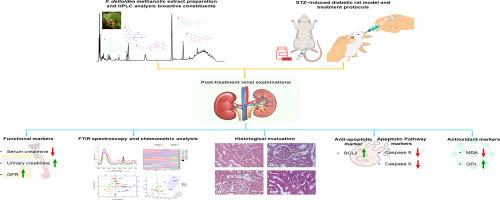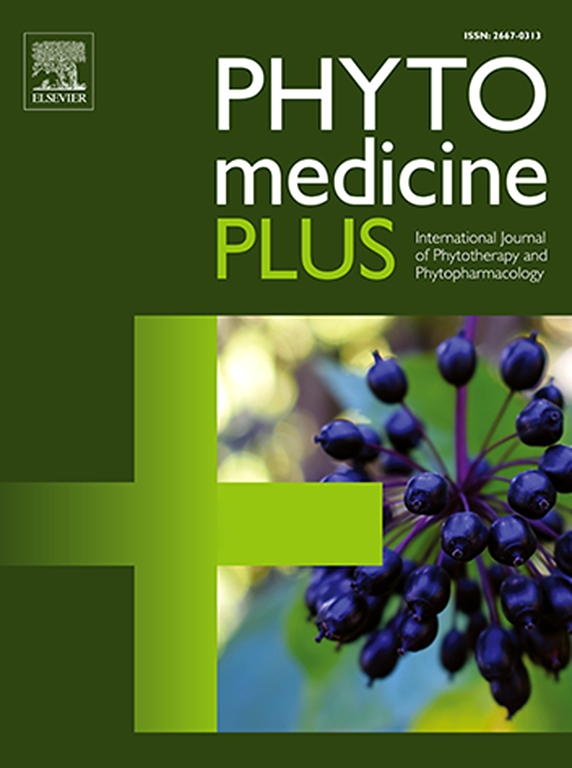榕树标准化甲醇提取物可改善大鼠肾脏结构和功能,对抗链脲佐菌素诱导的糖尿病肾病
Q3 Pharmacology, Toxicology and Pharmaceutics
引用次数: 0
摘要
背景氧化应激和外周胰岛素抵抗是糖尿病肾病的主要发病机制。我们以前曾证实,鹅掌楸能通过减少氧化应激增加糖尿病大鼠的胰岛素分泌并改善组织再生。方法采用高效液相色谱法(HPLC)鉴定榕树叶提取物中的黄酮类化合物。以 1000 毫克/千克体重的剂量给糖尿病大鼠口服 F. deltoidea 的甲醇提取物,连续八周。测量血清肌酐、尿素、尿酸、总胆红素和尿肌酐以评估肾功能。酶联免疫吸附试验(ELISA)评估了肾组织中氧化应激、抗氧化剂和细胞凋亡相关蛋白的水平。使用傅立叶变换红外光谱(FTIR)结合化学计量分析预测了与肾保护活性相关的光谱标记。用苏木精和伊红(H&E)染色的肾脏切片进行了组织形态学评价。结果高效液相色谱法确定了 F. deltoidea 甲醇叶提取物中含有牡荆素、异牡荆素、槲皮素和山柰酚。生化和组织学检查一致表明,三角枫提取物通过减少氧化应激和细胞凋亡改善了肾脏结构和功能。我们注意到,生化和病理变化与 1545 cm-1 和 1511 cm-1(酰胺 II)、1246 cm-1(DNA/RNA 磷酸骨架)和 1181 cm-1(C-O 振动)处的红外峰相对应。对红外光谱的多变量分析表明,用蟾酥提取物治疗的糖尿病大鼠与正常动物具有相似的聚类模式。傅立叶红外光谱可用于监测糖尿病治疗过程中肾脏的结构和生化变化。本文章由计算机程序翻译,如有差异,请以英文原文为准。

Ficus deltoidea standardized methanolic extract improves kidney structure and function against streptozotocin-induced diabetic nephropathy in rats
Background
Oxidative stress and peripheral insulin resistance are the key pathogenesis of diabetic nephropathy. We have previously demonstrated that Ficus deltoidea increases insulin secretion and improves tissue regeneration by reducing oxidative stress in diabetic rats. However, it remains uncertain whether F. deltoidea could delay the progression of nephropathy.
Hypothesis/Purpose
This study aimed to examine the nephroprotective effects of F. deltoidea on streptozotocin-induced diabetic nephropathy in rats.
Methods
High-Performance Liquid Chromatography (HPLC) was used to identify the flavonoid compounds in the leaf extract of F. deltoidea. The methanolic extract of F. deltoidea was administered orally at 1000 mg/kg body weight for eight weeks to diabetic rats. Serum creatinine, urea, uric acid, total bilirubin, and urinary creatinine were measured to estimate kidney function. Enzyme-linked immunosorbent assays (ELISA) assessed the levels of oxidative stress, antioxidants, and apoptosis-related proteins in the kidney tissue. The spectral markers related to nephroprotective activity were predicted using Fourier-transform infrared (FTIR) spectroscopy combined with chemometric analysis. Histomorphometric evaluations were performed on the kidney sections stained with hematoxylin and eosin (H&E).
Results
HPLC identified the presence of vitexin, isovitexin, quercetin, and kaempferol in F. deltoidea methanolic leaves extract. The biochemical and histological examinations consistently showed that F. deltoidea extract improved kidney structure and function by reducing oxidative stress and apoptosis. We noticed that biochemical and pathological changes corresponded to the infrared (IR) peaks at 1545 cm-1 and 1511 cm-1 (amide II), 1246 cm-1 (DNA/RNA phosphate backbones), and 1181 cm-1 (C–O vibrations). Multivariate analysis of IR spectra demonstrated that the diabetic rats treated with F. deltoidea extract had a similar clustering pattern to that of the normal animals.
Conclusion
These findings indicate that the methanolic extract of F. deltoidea exhibits nephroprotective activity. FTIR spectroscopy may be useful for monitoring structural and biochemical alterations in the kidney during diabetes treatment.
求助全文
通过发布文献求助,成功后即可免费获取论文全文。
去求助
来源期刊

Phytomedicine Plus
Medicine-Complementary and Alternative Medicine
CiteScore
3.70
自引率
0.00%
发文量
178
审稿时长
81 days
期刊介绍:
 求助内容:
求助内容: 应助结果提醒方式:
应助结果提醒方式:


